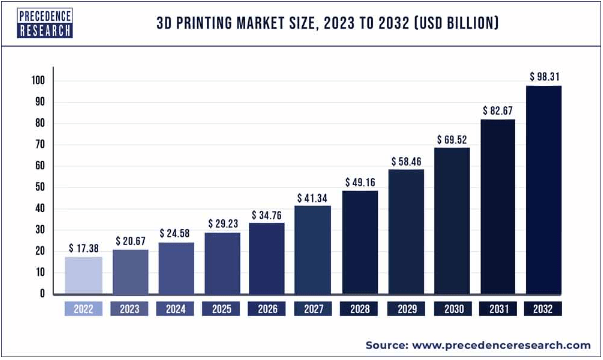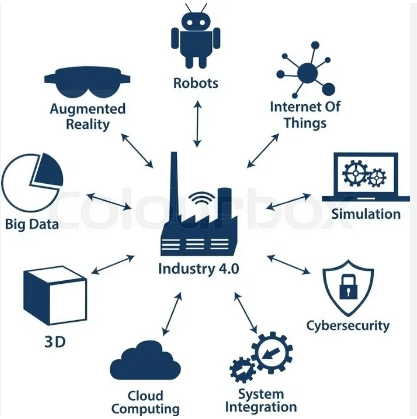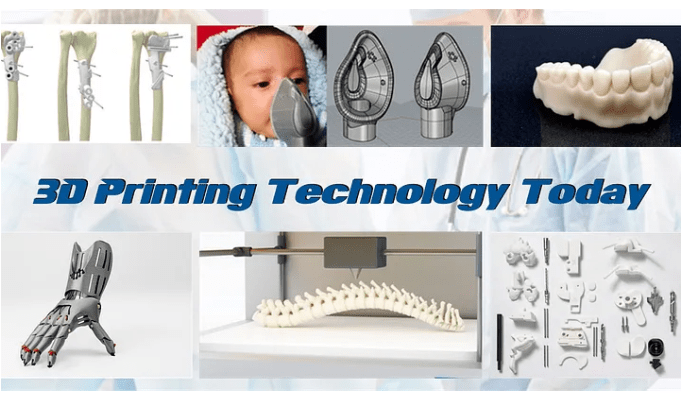Navigating through 3D Printing Statistics can be overwhelming, especially considering the rapid transformation of industries.
3D printing technology is reshaping industries at an unprecedented pace, but navigating its trend landscape can feel overwhelming. Did you know the global 3D printing market is predicted to reach $34.8 billion by 2024? This blog post aims to demystify this complex topic by sharing vital statistics and forecasting key trends for 2023 and beyond.
Let’s dive into the future of additive manufacturing!
Key Takeaways
- The global 3D printing market is predicted to reach $34.8 billion by 2024, with an annual growth rate of over 18% between 2020 and 2028.
- Two-thirds of companies are currently using or considering adopting 3D printing for production parts or custom prototypes.
- Digital supply chain integration is transforming the world of 3D printing by improving manufacturing processes and optimizing operations.
- Quality assurance measures in industrial printing ensure consistent, high-quality products that meet customer expectations.
- Sustainability initiatives aim to make 3D printing a greener and more sustainable manufacturing option for the future.
- Metal 3D printing is experiencing a rise in popularity due to advancements in technology, allowing for complex geometries, reduced material waste, and improved customization options.
Key 3D Printing Statistics
The key 3D printing statistics include market growth and forecasts, adoption and usage statistics, and the economic benefits of 3D printing.
Market growth and forecasts

Experts predict a robust expansion in the 3D printing market over the coming years. They forecast an annual growth rate of more than 18% between 2020 and 2028, pushing the global market value to an estimated $30 billion.
This explosion in growth comes amid increasing usage across various industries, from automotive to healthcare. Businesses are rapidly upskilling their workforce to adapt this innovative technology into their operations.
Furthermore, consumer awareness is rising, escalating demand for customized products achievable only through additive manufacturing processes such as 3D printing.
Adoption and usage statistics
The adoption and usage of 3D printing technology have steadily risen in recent years. According to analysts, the global 3D printing market is expected to significantly expand, with an annual growth rate of around 20% over the next five years.
This growth can be attributed to several factors, including the broader range of applications 3D printing offers across various industries, such as aerospace, automotive, healthcare, and consumer goods.
A business survey last year revealed that nearly two-thirds of companies currently use or consider adopting 3D printing for production parts or custom prototypes.
With advancements in additive manufacturing technology and increasing awareness about its benefits, we can expect even more businesses to upskill their workforce and explore innovative ways to leverage this technology.
The increased adoption of 3D printing is also evident from the surge in usage statistics. The number of 3D printers sold worldwide has steadily risen year after year. In addition, there has been a significant increase in the volume of materials used for additive manufacturing processes.
Economic benefits of 3D printing
3D printing offers significant economic benefits across various industries. One major advantage is the cost reduction in manufacturing and production processes. With 3D printing, companies can eliminate the need for expensive molds or tooling equipment, leading to substantial savings in upfront costs.
Additionally, 3D printing allows for on-demand production, reducing inventory expenses and the risk of overstocking or obsolescence. Moreover, by enabling customization and rapid prototyping, 3D printing accelerates product development cycles and enhances innovation.
This technology also promotes sustainability by minimizing waste through efficient material usage. As a result, businesses can improve their bottom line while staying competitive in an ever-evolving marketplace.
Major Trends in 3D Printing for 2023
In 2023, we can expect to see an increasing range of use cases for 3D printing, including digital supply chain integration, quality assurance in industrial printing, sustainability initiatives, and the rise of metal 3D printing.
Increasing range of use cases
The field of 3D printing is witnessing an increasing range of use cases, with its application scenarios expanding rapidly. From rapid prototyping to digital fabrication, this manufacturing technology is revolutionizing industries.
With advancements in material science and additive manufacturing techniques, businesses can now produce custom parts and products with unmatched precision and speed. The wider range of applications has created opportunities for product innovation, helping companies stay ahead in a competitive market.
As the adoption of 3D printing grows, we can expect even more diverse and creative uses for this transformative technology.
Digital supply chain integration

Digital supply chain integration is a major trend to watch in 3D printing. As technology advances, companies realize the benefits of incorporating digital solutions into their supply chains.
By integrating 3D printing technology, businesses can streamline manufacturing processes, reduce costs, and increase efficiency. This integration allows for faster production times and improved customization capabilities.
With digital supply chain integration, manufacturers can easily collaborate with suppliers and customers, share information seamlessly, and optimize their operations. It’s an exciting development revolutionizing how products are made and delivered.
In conclusion, digital supply chain integration is transforming the world of 3D printing by improving manufacturing processes and optimizing operations. Businesses are embracing this trend to reap the benefits of increased efficiency and reduced costs.
Quality assurance in industrial printing
Manufacturing technology has significantly advanced in recent years, with industrial printing playing a crucial role. Quality assurance is paramount in this field to ensure that the printed products meet the required standards.
Through rigorous testing and inspection processes, manufacturers can identify and rectify any flaws or defects before the final product reaches the market. With quality assurance measures in place, industrial printing can consistently produce high-quality products that meet customer expectations and contribute to overall customer satisfaction.
Sustainability initiatives
Companies and organizations are increasingly focusing on sustainability initiatives in 3D printing. This involves implementing environmentally friendly practices, from material sourcing to disposal.
Many companies are exploring using biodegradable materials and renewable energy sources to reduce their carbon footprint. Additionally, a growing emphasis is on recycling and reusing materials to minimize waste.
These sustainability initiatives aim to make 3D printing a greener and more sustainable manufacturing option for the future.
Rise of metal 3D printing
Metal 3D printing is experiencing a significant rise in popularity and adoption. This trend is driven by technological advancements that have made it possible to print metal parts with precision and efficiency.
Industries such as aerospace, automotive, and healthcare increasingly utilize metal 3D printing for applications ranging from prototyping to production. The ability to create complex geometries, reduce material waste, and improve customization options has made metal 3D printing a game-changer in the manufacturing industry.
As this technology continues to evolve, we can expect to see even more innovations and breakthroughs in metal additive manufacturing.
Recent Technological Advances in 3D Printing

Recent advances in 3D printing have revolutionized the industry, with AI-assisted printing, generative design, print optimization, medical innovations, and sustainability practices leading the way.
AI-assisted printing
AI-assisted printing is revolutionizing the 3D printing industry. With the help of artificial intelligence, printers can now optimize their performance and efficiency like never before.
AI algorithms analyze complex data sets to identify potential issues and provide real-time adjustments during the printing process. This technology improves print quality and reduces material waste and production time.
By leveraging AI, businesses can achieve higher accuracy, precision, and consistency in their prints, making it an essential tool for additive manufacturing in the future. Integrating AI into 3D printing processes opens up new possibilities for design complexity and customization, ensuring a brighter future for this innovative technology.
Generative design
Generative design is a cutting-edge technology that harnesses the power of artificial intelligence (AI) to create optimized designs. It uses algorithms to explore numerous options based on specified parameters and then generates the most efficient solution.
This innovative approach allows for greater creativity and exploration in design, resulting in lighter, stronger, and more sustainable products. With generative design, engineers can quickly iterate through various design concepts, saving time and resources.
Its potential impact on industries like manufacturing and aerospace is immense, as it enables the creation of complex structures that were previously unimaginable.
Print optimization
Print optimization is a crucial aspect of 3D printing that focuses on improving the efficiency and quality of printed objects. Manufacturers can minimize material waste and reduce production time by fine-tuning various parameters such as layer thickness, infill density, and print speed.
This process leads to cost savings and ensures that the final output meets or exceeds the desired specifications. With advancements in software algorithms and machine learning techniques, print optimization is becoming increasingly precise and automated, enabling businesses to achieve higher productivity and better outcomes in their additive manufacturing processes.
Medical industry innovations

Recent advancements in 3D printing technology have brought about a wave of innovations in the medical industry. One significant development is using 3D printing to create customized medical implants and prosthetics.
With this technology, doctors can now design and produce implants that perfectly fit a patient’s unique anatomy, leading to better outcomes and improved quality of life. Additionally, 3D printing enables the production of complex structures, such as organ models, for surgical planning and training purposes.
This innovative approach allows surgeons to practice procedures beforehand, reducing risks during actual surgeries. The potential applications of 3D printing in healthcare are vast, offering new solutions for personalized medicine and revolutionizing patient care.
Another area where 3D printing has made strides in the medical field is bioprinting. Scientists use specialized printers that deposit living cells layer by layer to create functional human tissues and organs.
This breakthrough technology holds incredible promise for regenerative medicine, providing hope for patients waiting for organ transplants or suffering from tissue damage or degenerative diseases.
Sustainability practices
Companies in the 3D printing industry are increasingly adopting sustainability practices to reduce their environmental impact. They use biodegradable materials and explore ways to minimize waste while maximizing production efficiency.
This focus on sustainability is driven by a growing awareness of the importance of environmentally friendly manufacturing processes and the desire to meet consumer demands for more eco-friendly products.
By implementing these practices, companies can reduce their carbon footprint, improve their brand reputation, and attract environmentally conscious customers.
Conclusion: Looking Ahead to the Future of 3D Printing
In conclusion, the future of 3D printing looks promising, with several key trends to watch in 2023 and beyond. The increasing range of use cases, digital supply chain integration, quality assurance in industrial printing, sustainability initiatives, and the rise of metal 3D printing are all set to shape the industry.
As technology advances and businesses embrace additive manufacturing, we expect even more innovations and growth in the coming years.
Read More
Also, read Actionable Marketing Trends On Consumer Behavior In 2023.
Frequently Asked Questions (FAQs)
What is the current state of 3D printing?
The current state of 3D printing includes additive manufacturing trends, the production of parts, and a growing market for industrial 3D printing.
What are some top trends to watch in 2023 and beyond?
Some top trends include the future of 3D bioprinting, the expansion of the industry with a broader range of applications, and increased usage due to supply chain disruption.
Can you tell me about the growth of the 3D printing market?
The market’s growth involves more businesses adopting this method for part production, increasing its application in industrial sectors, which leads to overall expansion.
How has industrial 3D printing changed over time?
Industrial 3D printing has evolved from basic models to sophisticated creations, including advances in bioprinting, leading to new use cases such as producing human organs or tissues.
How does supply chain disruption affect the increase in usage?
Supply chain disruptions have led companies towards localized production via methods like 3D printing, resulting in increased demand – offering faster turnarounds while reducing costs associated with overseas shipping.



